|
| |
The LGM-30G Minuteman III ICBMs
are the land-based nuclear tools that guard our country from nuclear attack
by another nation, by virtue of counter-attack capability from widely-dispersed,
hidden locations in the US. They are designed to carry 3 MIRVs but are currently
limited to carry only 1 RV due to START treaty conditions.
Minutemans have been around since the early 1960's,
and with upgrade programs to their motors and guidance now happening, will fly
until 2020. There are 500 of these missiles fielded in the US.
building
one of the many hidden, underground launch silos
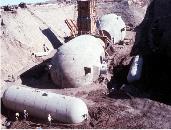
|
the
milkman delivers...
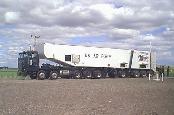
|
silo
loading
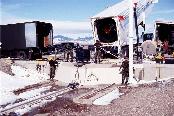
|
silo
loading

|
silo
loading
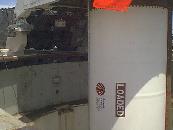
|
silo
loading
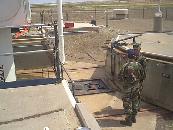
|
post-load
missile arming

|
post-load
missile arming
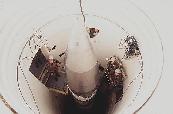
|
post-load
missile arming
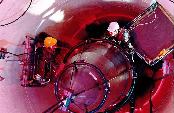
|
a
finished site
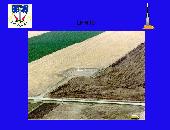
|
another
finished site
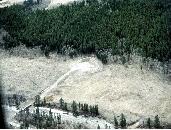
|
W87 nuclear warhead &
re-entry vehicle (RV)
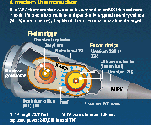
|
Autonetics D17B Minuteman Missile Guidance Computer
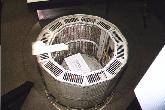
|
launch,
start

|
launch,
away
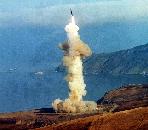
|
launch,
ascent & accelerate

|
ascent
close-up

|
ascent
close-up

|
launch
video (1.4 MB)

|
one
of many RVs arrives
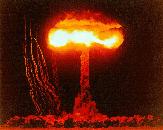
|
A successor to the Minuteman III, the
LG-118A "MX" or "Peacekeeper" missile, was developed and
fielded. The entire system is comprised of 50 missiles and many mobile
railway launchers moving continuously (no fixed silos to take out on a first
strike). However, START II honoring is deactivating all Peacekeepers through
2007 (in exchange for the USSR retiring their SS-18's) -- eventually leaving us
only with MM III's for land-launched ICBM capability, plus a whole bunch of W87
warheads for Minuteman III or Trident II use. The MXs are much bigger
than the Minuteman IIIs, at 193,000 pounds (versus MM III's 78,000 pounds).
Unlike the Minuteman, they don't "hot-launch" from their silos but
instead get pushed out first to a substantial height above the silo before
igniting (like the Trident SLBMs do). Like the Minuteman, they are designed to carry many W87-armed MIRVs
(10 versus Minuteman's 3). Also, they have a comparable range of over 6000 miles
and are traveling at 15,000 mph upon motor burnout. They had a major improvement
over the Minuteman III in their guidance control, which has since been
incorporated into the Minuteman IIIs via GRP (Guidance Replacement Program).
MX
launch
(test launch from Vandenberg AFB)

|
MX
launch
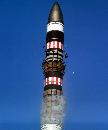
|
MM
III vs. MX

|
mobile
launcher dwarfs nearby man
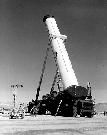
|
MX MIRVs' flight
path traces
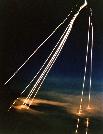
|
|
MX MIRV loading
(ten W87s per
MX)
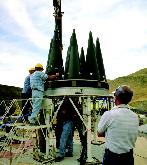
|
capping
the MIRV load
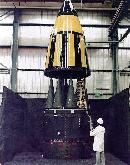
|
Advanced
Inertial Reference Sphere
(INS drift
rates of less than 1.5 x 10^-5 degrees per hour of operation)
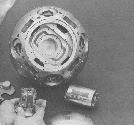
|
MX
Launch video
(AVI, 1.6 MB)
|
|
For more detail on the MX, go here,
or better yet here.
What's next? maybe Minuteman IV.
"Over the last year, the force applications team has
secured SMC's role in the future missile system commonly referred to as
Minuteman IV that hopes to be a $20-30 billion procurement between 2004 and
2040. New missions for the system include holding both hardened and deeply
buried targets and strategic relocatable targets at risk. Concepts being
evaluated for these missions may include an earth penetrator reentry vehicle or
a "smart" maneuvering reentry vehicle. With respect to force
applications, the Minuteman IV activity is simply the first initiative, among
many, for possible future space weapon systems. In parallel with the Minuteman
IV is another effort addressing conventional prompt global strike needs which is
referred to as the Common Aero Vehicle
(CAV)." Schriever Legacy Carries
on in XR, The XR Report, A Quarterly Newsletter of the Developmental
Planning Directorate, SMC, Vol. 3 no. 2, JanMar 2001.
The Air Force SAB Hypersonics Report described the Common
Aero Vehicle program as follows:
"Boeing and Lockheed Martin have been participating in Air Force-sponsored
studies of advanced maneuvering reentry vehicles, often referred to as CAVs (see
Figure 21). These vehicles with high lift-to-drag ratios have no primary
propulsion, but have movable surfaces to provide high cross-range capability.
They are designed to carry conventional weapons (small bombs, submunitions, or
penetrators) and can be deployed from conventional ICBMs or a hypersonic cruise
vehicle operating at high altitude." (p. 35)
TRW (now Northrop Grumman) was awarded the prime ICBM integrator
contract by the USAF in 1997, which gives them the responsibility to sustain and
modernize all ICBMs. As such, they are expected to play a key role in the
development of MM IV vendors, technologies, systems, and ultimately an overall
vehicle. TRW has provided systems engineering and technical assistance to the ICBM System Program Office (SPO), now located at Hill Air Force Base, Utah, since 1954.
Report dead links to the webmaster.
This page was last updated on 02/19/05
.
|